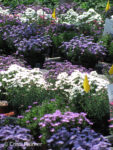This first appeared as “Spotlight on Ornamentals: Spring Forward for Fall” in the IR-4 Newsletter 48(2):8.
It is currently late spring, so it seems a little unusual to be talking about fall color but growers are already producing plants for fall color. Autumn in most parts of the United States brings spectacular color to foliage as temperature drops and chlorophyll breaks down to reveal yellow, orange and red foliage. But leaves are not the only showy plant feature in autumn. Flower color during fall is often associated with chrysanthemum, but several other perennial plants bloom during this time. Two other fall-flowering composites are aster and sneezeweed.
Aster
Plant Information
 Aster flowers range in color from white to shades of pink and purple. For many years, the Latin genera Aster has had close to 600 species in Eurasia and North America, but now almost all of the native asters in North America have been reclassified to a new genera by plant taxonomists based new phylogenetic trees developed by studying the genetic similarities and differences among these species. The well-known New England aster is now named Symphyotrichum novae-angliae.
Aster flowers range in color from white to shades of pink and purple. For many years, the Latin genera Aster has had close to 600 species in Eurasia and North America, but now almost all of the native asters in North America have been reclassified to a new genera by plant taxonomists based new phylogenetic trees developed by studying the genetic similarities and differences among these species. The well-known New England aster is now named Symphyotrichum novae-angliae.
Main Disease and Pest Problems
Aster are prone to several foliage diseases including leaf spots (Septoria, Alternaria, Cercospora), rust (Coleosporium asterum), and powdery mildew (Erysiphe cichoracearum). The flowers are susceptible to Botrytis blight, and the stems and roots can be infected by various pathogens including Fusarium, Verticillium, Sclerotinia, Pythium and Phytophthora. Common pests include aphids, lace bugs, leaf miner, scales, spider mites, thrips and whiteflies.
Aster attract butterflies, and the larvae feed on the aster foliage.
Sneezeweed
Plant Information
The story of how this flower, native to the Americas, received its common name is not fully clear. Some sources indicate this common name is based on Native Americans drying the leaves for snuff to rid the body of evil spirits. Other sources indicate Native Americans used dried flower petals and used them to prevent hay fever. Native Helenium autumnale typically blooms from late summer until frost, but many modern cultivars are hybrids with other Helenium species and may blooms earlier in midsummer. Helenium flowers can be shades of gold, yellow, orange and red-orange.
Main Disease and Pest Problems
Helenium tends to be pest free with occasional issues caused by aphids, leafhoppers, and spider mites. Similar to asters, the common disease problems include fungal leaf spots, powdery mildew, root rots, and rust. Slugs, snails and nematodes can also feed on Helenium.
Aster and Sneezeweed Growing Tips From gardeningknowhow.com
Aster
Aster flowers (Aster spp.) add color to the autumn landscape while offering beauty with little work when caring for asters. Growing asters often bloom in late summer and fall, but the Alpine aster offers blooms in spring. Learning how to grow aster is easy and rewarding when the star shaped flowers bloom in the landscape.
Types of Asters
Aster flowers may reach 3 to 4 feet or can be compact and mounding as with the Alpine type. Six-hundred or more varieties of aster exist. Pair asters in the natural garden with coneflowers and goldenrod for a striking display. Caring for asters can include staking and/or pruning taller types for a bushier and more compact plant.
How to Grow Asters
Growing asters is a simple garden chore. They may be started from seed in spring, but are most often purchased as a potted plant. Plant into a full sun to part sun location in loamy, well-draining soil. Keep new plantings moist and continue watering until blooms cease.
Appropriate care of aster includes watering at the base and not splashing the foliage. Getting water or fertilizer on the leaves encourages powdery mildew and other fungal diseases. Organic mulch can hold in moisture and supply nutrients as it breaks down. Apply within a few inches of aster stems, but not against them. Fertilize growing asters with a balanced plant food about once a month.
Asters need little in the way of maintenance. Care of asters may include deadheading for more blooms and occasionally includes controlling powdery mildew. This disease is most easily prevented by autumn or spring division of aster flowers, with the middle clump removed and discarded.
Powdery mildew can also be controlled with insecticidal sprays and soaps, if started early and regularly applied during the growing season. Powdery mildew usually does no lasting damage to aster flowers, but should be controlled for aesthetic purposes. Spraying may also deter the small, gray lace bug, which sometimes feeds on the succulent growth of growing asters.
Include a plot of aster flowers in the garden for fall color and beauty. Plant shorter types to accompany fall blooming mums. This hardy perennial will return for years of autumn color.
Read more at Gardening Know How: Growing Asters – How To Grow Aster Flowers In Your Garden https://www.gardeningknowhow.com/ornamental/flowers/asters/growing-asters.htm
Sneezeweed
Many of our prettiest garden plants bear the stigma of having the word “weed” included in their name. Sneezeweed was hit with a double whammy by having the word “weed” combined with a reference to spring allergies and hayfever. Fortunately, sneezeweed is not a weed, and a garden full of blooming sneezeweed won’t make you sneeze. Let’s learn more about sneezeweed uses in the garden.
What is Sneezeweed?
Sneezeweed plants (Helenium autumnale) produce pretty little daisy-like flowers, sometimes in shades of pale yellow and sometimes in rich, autumn shades such as gold and reddish-brown. The flowers cover 3- to 5-foot tall mounds of foliage for about three months in the fall.
Aside from the name, sneezeweed’s reputation suffers from the fact that it blooms at the same time as some of our worst fall allergy plants. This makes it hard to determine the exact source of allergy problems. Airborne pollen is usually the cause, but sneezeweed’s pollen rarely becomes airborne. The individual particles of pollen are so large and sticky that it takes a strong insect, such as a bee, to move it around.
The name sneezeweed comes from the fact that Native Americans dried the plant’s leaves to make snuff. Using the snuff caused hard sneezing, which was thought to drive evil spirits out of the head.
Sneezeweed Uses in Gardens
Use sneezeweed to extend the life of your garden well past the first fall frosts. The plants look best in a cottage garden setting. When growing sneezeweed plants in traditional borders, you’ll have to prune and stake them to keep the plants well-behaved.
Sneezeweed is ideal for prairies, meadows and naturalized areas. Use them in the moist to wet soils along bodies of water. You may find sneezeweed wildflowers growing naturally around ponds and along drainage ditches.
Clumps of sneezeweed make excellent additions to wildlife gardens where they help support insect populations. The Xerces Society for Invertebrate Conservation recommends planting sneezeweed to help support bees. The flowers are also known to attract butterflies.
Care of Sneezeweed Plants
Set out sneezeweed plants in spring when the soil begins to warm. They need rich, moist or wet soil in a location with full sun. Unless the soil is poor, the plants won’t need supplemental fertilizer.
Compact plants are easier to grow than the 4- to 5-foot tall varieties. If you choose a taller type, cut it back to a height of about 8 inches in early summer, and again by about half right after the flowers bloom. You only need to shear the tops of compact varieties after they finish flowering.
Although they won’t flower as profusely, you can grow the taller varieties to their full height. Plants over 3 feet tall will probably need staking. Lift, divide and replant the clumps every three to five years in spring or fall to maintain good health.
Read more at Gardening Know How: Care Of Sneezeweed: Tips For Growing Sneezeweed Wildflowers https://www.gardeningknowhow.com/ornamental/flowers/sneezeweed-flowers/growing-sneezeweed-wildflowers.htm
Sources Cited
https://www.gardeningknowhow.com/ornamental/flowers/sneezeweed-flowers/growing-sneezeweed-wildflowers.htm


